Aviation Management: Screening Process and Security Vulnerabilities
VerifiedAdded on 2023/04/26
|13
|4130
|237
AI Summary
This article discusses the screening process in aviation management and the security vulnerabilities faced by the industry. It covers the history of terrorist attacks, the importance of screening, its limitations, and the need for advanced technologies. The article also highlights the failures of the screening process and the role of human errors and screening companies in creating security vulnerabilities.
Contribute Materials
Your contribution can guide someone’s learning journey. Share your
documents today.
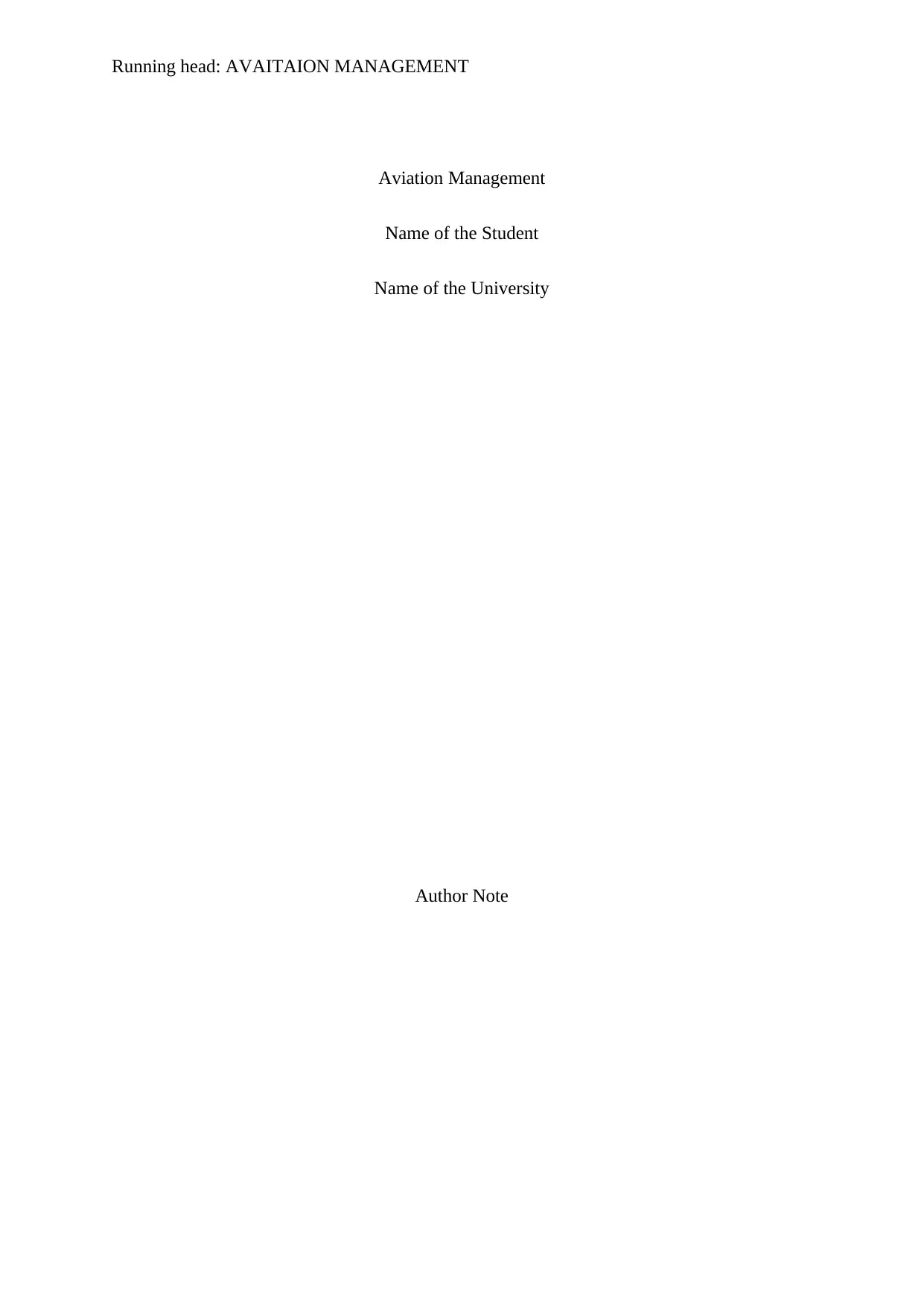
Running head: AVAITAION MANAGEMENT
Aviation Management
Name of the Student
Name of the University
Author Note
Aviation Management
Name of the Student
Name of the University
Author Note
Secure Best Marks with AI Grader
Need help grading? Try our AI Grader for instant feedback on your assignments.
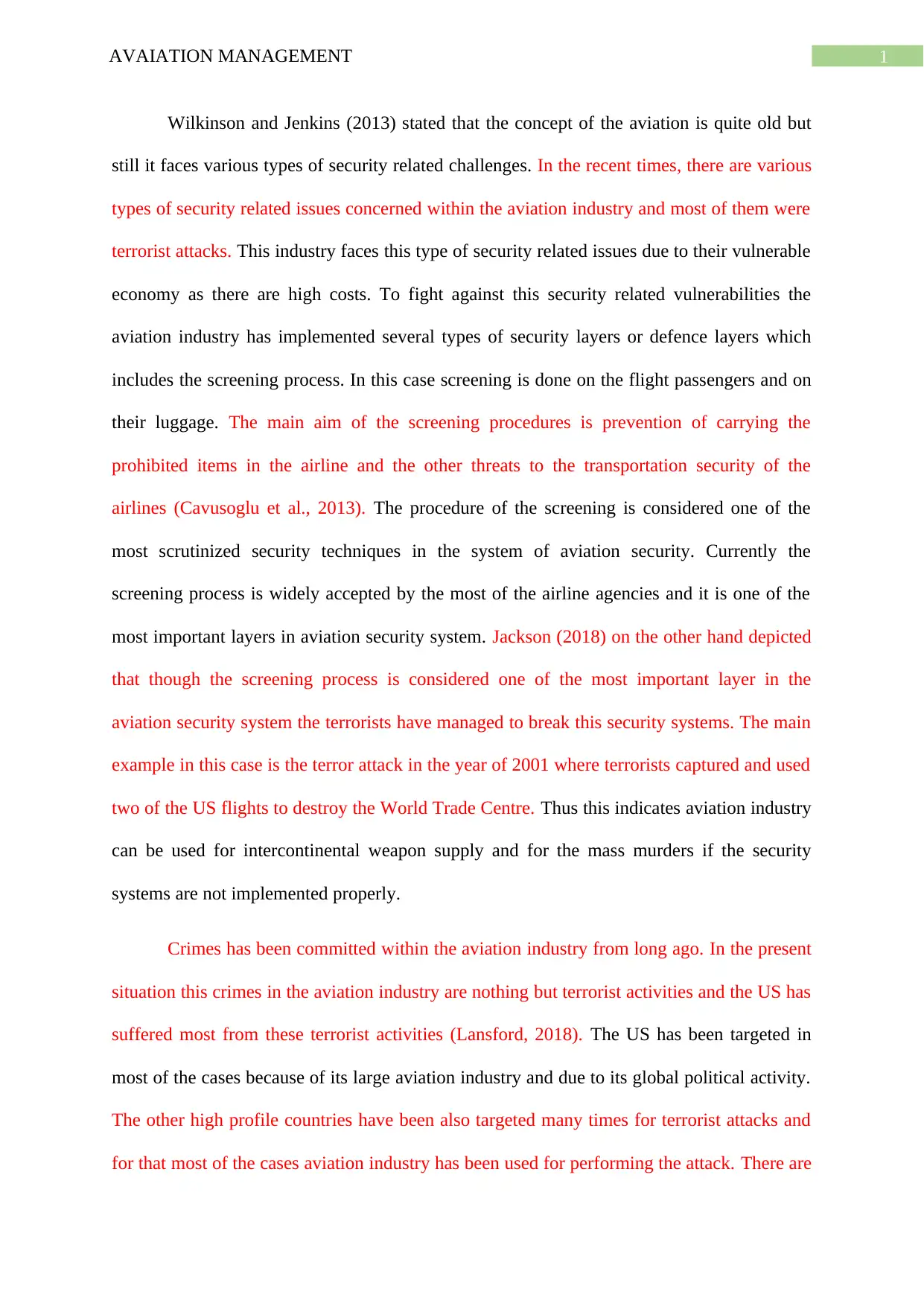
1AVAIATION MANAGEMENT
Wilkinson and Jenkins (2013) stated that the concept of the aviation is quite old but
still it faces various types of security related challenges. In the recent times, there are various
types of security related issues concerned within the aviation industry and most of them were
terrorist attacks. This industry faces this type of security related issues due to their vulnerable
economy as there are high costs. To fight against this security related vulnerabilities the
aviation industry has implemented several types of security layers or defence layers which
includes the screening process. In this case screening is done on the flight passengers and on
their luggage. The main aim of the screening procedures is prevention of carrying the
prohibited items in the airline and the other threats to the transportation security of the
airlines (Cavusoglu et al., 2013). The procedure of the screening is considered one of the
most scrutinized security techniques in the system of aviation security. Currently the
screening process is widely accepted by the most of the airline agencies and it is one of the
most important layers in aviation security system. Jackson (2018) on the other hand depicted
that though the screening process is considered one of the most important layer in the
aviation security system the terrorists have managed to break this security systems. The main
example in this case is the terror attack in the year of 2001 where terrorists captured and used
two of the US flights to destroy the World Trade Centre. Thus this indicates aviation industry
can be used for intercontinental weapon supply and for the mass murders if the security
systems are not implemented properly.
Crimes has been committed within the aviation industry from long ago. In the present
situation this crimes in the aviation industry are nothing but terrorist activities and the US has
suffered most from these terrorist activities (Lansford, 2018). The US has been targeted in
most of the cases because of its large aviation industry and due to its global political activity.
The other high profile countries have been also targeted many times for terrorist attacks and
for that most of the cases aviation industry has been used for performing the attack. There are
Wilkinson and Jenkins (2013) stated that the concept of the aviation is quite old but
still it faces various types of security related challenges. In the recent times, there are various
types of security related issues concerned within the aviation industry and most of them were
terrorist attacks. This industry faces this type of security related issues due to their vulnerable
economy as there are high costs. To fight against this security related vulnerabilities the
aviation industry has implemented several types of security layers or defence layers which
includes the screening process. In this case screening is done on the flight passengers and on
their luggage. The main aim of the screening procedures is prevention of carrying the
prohibited items in the airline and the other threats to the transportation security of the
airlines (Cavusoglu et al., 2013). The procedure of the screening is considered one of the
most scrutinized security techniques in the system of aviation security. Currently the
screening process is widely accepted by the most of the airline agencies and it is one of the
most important layers in aviation security system. Jackson (2018) on the other hand depicted
that though the screening process is considered one of the most important layer in the
aviation security system the terrorists have managed to break this security systems. The main
example in this case is the terror attack in the year of 2001 where terrorists captured and used
two of the US flights to destroy the World Trade Centre. Thus this indicates aviation industry
can be used for intercontinental weapon supply and for the mass murders if the security
systems are not implemented properly.
Crimes has been committed within the aviation industry from long ago. In the present
situation this crimes in the aviation industry are nothing but terrorist activities and the US has
suffered most from these terrorist activities (Lansford, 2018). The US has been targeted in
most of the cases because of its large aviation industry and due to its global political activity.
The other high profile countries have been also targeted many times for terrorist attacks and
for that most of the cases aviation industry has been used for performing the attack. There are
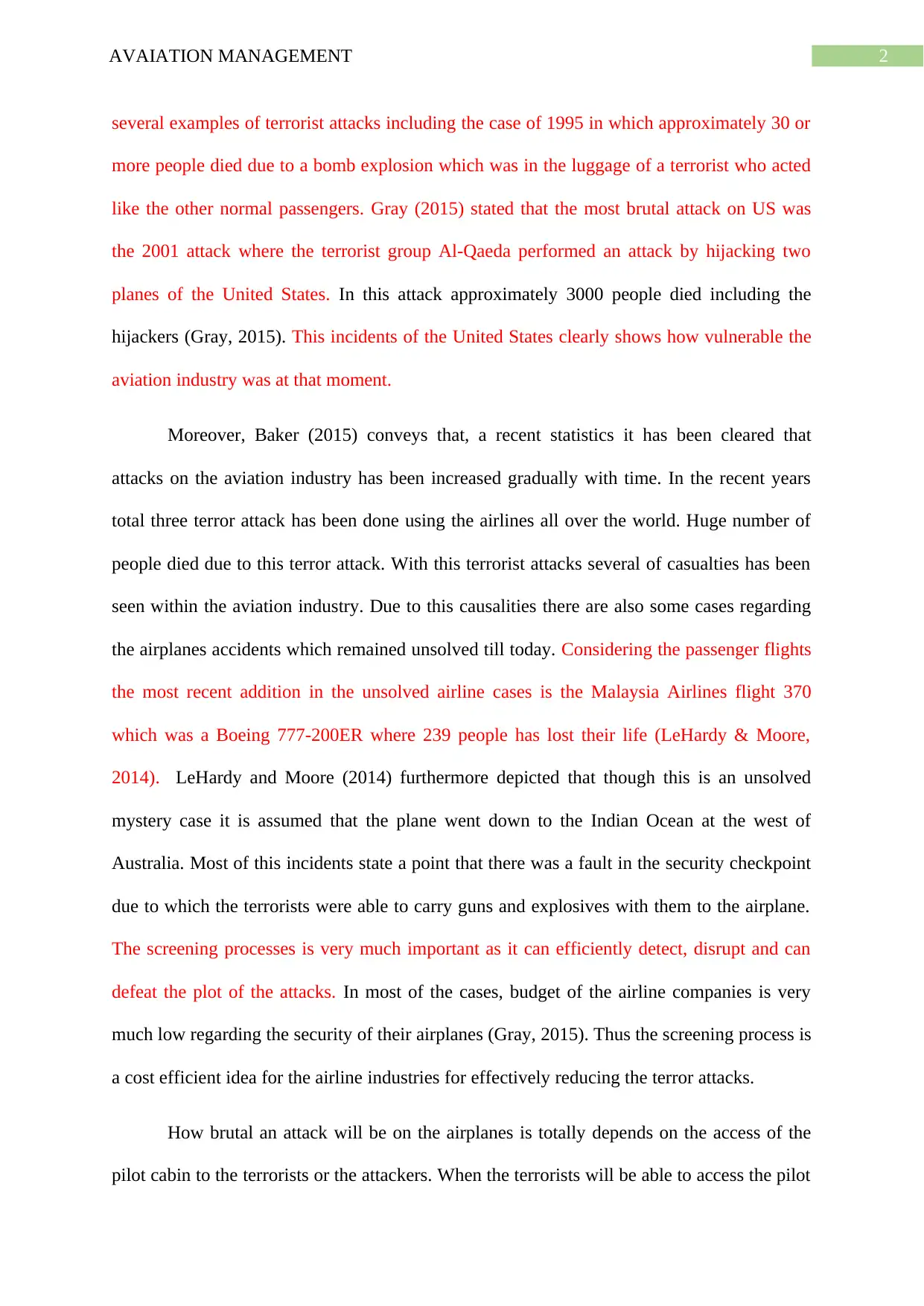
2AVAIATION MANAGEMENT
several examples of terrorist attacks including the case of 1995 in which approximately 30 or
more people died due to a bomb explosion which was in the luggage of a terrorist who acted
like the other normal passengers. Gray (2015) stated that the most brutal attack on US was
the 2001 attack where the terrorist group Al-Qaeda performed an attack by hijacking two
planes of the United States. In this attack approximately 3000 people died including the
hijackers (Gray, 2015). This incidents of the United States clearly shows how vulnerable the
aviation industry was at that moment.
Moreover, Baker (2015) conveys that, a recent statistics it has been cleared that
attacks on the aviation industry has been increased gradually with time. In the recent years
total three terror attack has been done using the airlines all over the world. Huge number of
people died due to this terror attack. With this terrorist attacks several of casualties has been
seen within the aviation industry. Due to this causalities there are also some cases regarding
the airplanes accidents which remained unsolved till today. Considering the passenger flights
the most recent addition in the unsolved airline cases is the Malaysia Airlines flight 370
which was a Boeing 777-200ER where 239 people has lost their life (LeHardy & Moore,
2014). LeHardy and Moore (2014) furthermore depicted that though this is an unsolved
mystery case it is assumed that the plane went down to the Indian Ocean at the west of
Australia. Most of this incidents state a point that there was a fault in the security checkpoint
due to which the terrorists were able to carry guns and explosives with them to the airplane.
The screening processes is very much important as it can efficiently detect, disrupt and can
defeat the plot of the attacks. In most of the cases, budget of the airline companies is very
much low regarding the security of their airplanes (Gray, 2015). Thus the screening process is
a cost efficient idea for the airline industries for effectively reducing the terror attacks.
How brutal an attack will be on the airplanes is totally depends on the access of the
pilot cabin to the terrorists or the attackers. When the terrorists will be able to access the pilot
several examples of terrorist attacks including the case of 1995 in which approximately 30 or
more people died due to a bomb explosion which was in the luggage of a terrorist who acted
like the other normal passengers. Gray (2015) stated that the most brutal attack on US was
the 2001 attack where the terrorist group Al-Qaeda performed an attack by hijacking two
planes of the United States. In this attack approximately 3000 people died including the
hijackers (Gray, 2015). This incidents of the United States clearly shows how vulnerable the
aviation industry was at that moment.
Moreover, Baker (2015) conveys that, a recent statistics it has been cleared that
attacks on the aviation industry has been increased gradually with time. In the recent years
total three terror attack has been done using the airlines all over the world. Huge number of
people died due to this terror attack. With this terrorist attacks several of casualties has been
seen within the aviation industry. Due to this causalities there are also some cases regarding
the airplanes accidents which remained unsolved till today. Considering the passenger flights
the most recent addition in the unsolved airline cases is the Malaysia Airlines flight 370
which was a Boeing 777-200ER where 239 people has lost their life (LeHardy & Moore,
2014). LeHardy and Moore (2014) furthermore depicted that though this is an unsolved
mystery case it is assumed that the plane went down to the Indian Ocean at the west of
Australia. Most of this incidents state a point that there was a fault in the security checkpoint
due to which the terrorists were able to carry guns and explosives with them to the airplane.
The screening processes is very much important as it can efficiently detect, disrupt and can
defeat the plot of the attacks. In most of the cases, budget of the airline companies is very
much low regarding the security of their airplanes (Gray, 2015). Thus the screening process is
a cost efficient idea for the airline industries for effectively reducing the terror attacks.
How brutal an attack will be on the airplanes is totally depends on the access of the
pilot cabin to the terrorists or the attackers. When the terrorists will be able to access the pilot
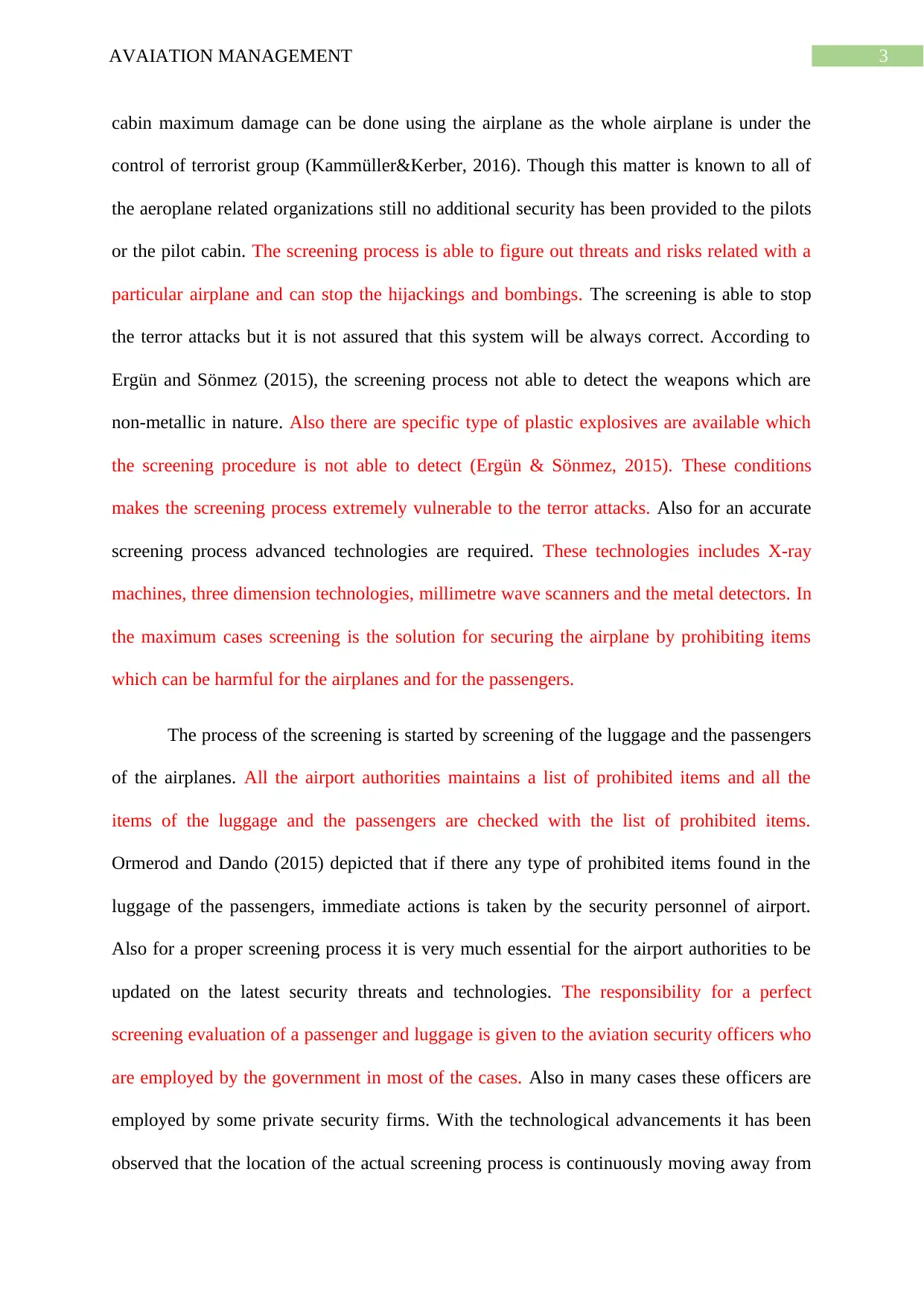
3AVAIATION MANAGEMENT
cabin maximum damage can be done using the airplane as the whole airplane is under the
control of terrorist group (Kammüller&Kerber, 2016). Though this matter is known to all of
the aeroplane related organizations still no additional security has been provided to the pilots
or the pilot cabin. The screening process is able to figure out threats and risks related with a
particular airplane and can stop the hijackings and bombings. The screening is able to stop
the terror attacks but it is not assured that this system will be always correct. According to
Ergün and Sönmez (2015), the screening process not able to detect the weapons which are
non-metallic in nature. Also there are specific type of plastic explosives are available which
the screening procedure is not able to detect (Ergün & Sönmez, 2015). These conditions
makes the screening process extremely vulnerable to the terror attacks. Also for an accurate
screening process advanced technologies are required. These technologies includes X-ray
machines, three dimension technologies, millimetre wave scanners and the metal detectors. In
the maximum cases screening is the solution for securing the airplane by prohibiting items
which can be harmful for the airplanes and for the passengers.
The process of the screening is started by screening of the luggage and the passengers
of the airplanes. All the airport authorities maintains a list of prohibited items and all the
items of the luggage and the passengers are checked with the list of prohibited items.
Ormerod and Dando (2015) depicted that if there any type of prohibited items found in the
luggage of the passengers, immediate actions is taken by the security personnel of airport.
Also for a proper screening process it is very much essential for the airport authorities to be
updated on the latest security threats and technologies. The responsibility for a perfect
screening evaluation of a passenger and luggage is given to the aviation security officers who
are employed by the government in most of the cases. Also in many cases these officers are
employed by some private security firms. With the technological advancements it has been
observed that the location of the actual screening process is continuously moving away from
cabin maximum damage can be done using the airplane as the whole airplane is under the
control of terrorist group (Kammüller&Kerber, 2016). Though this matter is known to all of
the aeroplane related organizations still no additional security has been provided to the pilots
or the pilot cabin. The screening process is able to figure out threats and risks related with a
particular airplane and can stop the hijackings and bombings. The screening is able to stop
the terror attacks but it is not assured that this system will be always correct. According to
Ergün and Sönmez (2015), the screening process not able to detect the weapons which are
non-metallic in nature. Also there are specific type of plastic explosives are available which
the screening procedure is not able to detect (Ergün & Sönmez, 2015). These conditions
makes the screening process extremely vulnerable to the terror attacks. Also for an accurate
screening process advanced technologies are required. These technologies includes X-ray
machines, three dimension technologies, millimetre wave scanners and the metal detectors. In
the maximum cases screening is the solution for securing the airplane by prohibiting items
which can be harmful for the airplanes and for the passengers.
The process of the screening is started by screening of the luggage and the passengers
of the airplanes. All the airport authorities maintains a list of prohibited items and all the
items of the luggage and the passengers are checked with the list of prohibited items.
Ormerod and Dando (2015) depicted that if there any type of prohibited items found in the
luggage of the passengers, immediate actions is taken by the security personnel of airport.
Also for a proper screening process it is very much essential for the airport authorities to be
updated on the latest security threats and technologies. The responsibility for a perfect
screening evaluation of a passenger and luggage is given to the aviation security officers who
are employed by the government in most of the cases. Also in many cases these officers are
employed by some private security firms. With the technological advancements it has been
observed that the location of the actual screening process is continuously moving away from
Secure Best Marks with AI Grader
Need help grading? Try our AI Grader for instant feedback on your assignments.

4AVAIATION MANAGEMENT
the aircrafts due to the change in the attack types, increased equipment cost for the screening
process and due to the increased number of passengers regularly (LeHardy & Moore, 2014).
Moreover, Kirschenbaum (2013) stated that it has been assessed that the airport
security systems always remained vulnerable to new innovations of the terrorists for
performing an attack. As the baggage screening process can detect the mainstreams
explosives and guns the terrorists has taken a unique approach of terrorism which is suicide
bombing and third party bombing (Horowitz, 2015). Also it has been assessed that many of
the airport authorities has failed to detect the risk potential and the damage potential by the
terror attacks and for that failed to initiate proper security mechanism. Thus, only relying on
screening process is not the ultimate solution for stopping the terrorism. Also, the quality of
screening process needs to be assessed cautiously so that maximum number of terror cases
can be stopped before initiation. Salmon et al. (2013) also conveyed that the quality of the
screening process can be assessed by probability of detecting the prohibited items in the
luggage against the classification of the threat and by assessing the rate of false alarm trigger.
In practical sense effectiveness of the screening process can be measured by decreasing
number of terrorism due to the checkout fault and by increased number of prohibited item
discovering at the security checkpoint. It has been assessed that there are total two model of
screening process. These two screening models are the basic screening model and the
investigatory screening model. The basic process of the screening is used in most of the
airport terminals. The investigatory screening model is the process of risk based screening
and also known as the profiling. Cavusoglu et al. (2013) on the other hand conveyed that
profiling is very much essential for reducing the time taken for the screening process. Thus
profiling becomes useful when there is increased number of passengers waiting at the
terminal. This screening process is focused on passengers rather than the prohibited items
which has reduced the overall terrorism in the world within the aviation industry.
the aircrafts due to the change in the attack types, increased equipment cost for the screening
process and due to the increased number of passengers regularly (LeHardy & Moore, 2014).
Moreover, Kirschenbaum (2013) stated that it has been assessed that the airport
security systems always remained vulnerable to new innovations of the terrorists for
performing an attack. As the baggage screening process can detect the mainstreams
explosives and guns the terrorists has taken a unique approach of terrorism which is suicide
bombing and third party bombing (Horowitz, 2015). Also it has been assessed that many of
the airport authorities has failed to detect the risk potential and the damage potential by the
terror attacks and for that failed to initiate proper security mechanism. Thus, only relying on
screening process is not the ultimate solution for stopping the terrorism. Also, the quality of
screening process needs to be assessed cautiously so that maximum number of terror cases
can be stopped before initiation. Salmon et al. (2013) also conveyed that the quality of the
screening process can be assessed by probability of detecting the prohibited items in the
luggage against the classification of the threat and by assessing the rate of false alarm trigger.
In practical sense effectiveness of the screening process can be measured by decreasing
number of terrorism due to the checkout fault and by increased number of prohibited item
discovering at the security checkpoint. It has been assessed that there are total two model of
screening process. These two screening models are the basic screening model and the
investigatory screening model. The basic process of the screening is used in most of the
airport terminals. The investigatory screening model is the process of risk based screening
and also known as the profiling. Cavusoglu et al. (2013) on the other hand conveyed that
profiling is very much essential for reducing the time taken for the screening process. Thus
profiling becomes useful when there is increased number of passengers waiting at the
terminal. This screening process is focused on passengers rather than the prohibited items
which has reduced the overall terrorism in the world within the aviation industry.
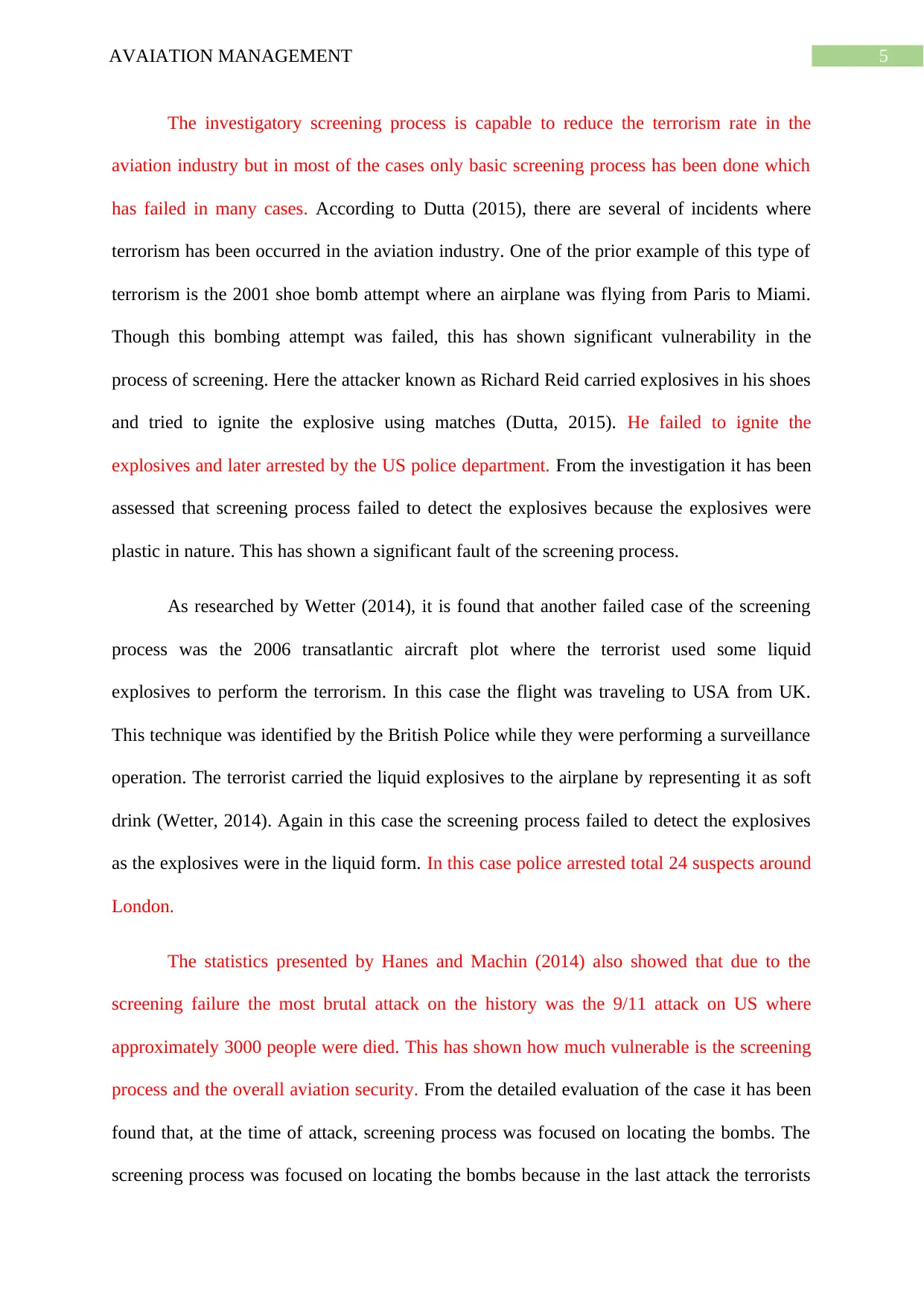
5AVAIATION MANAGEMENT
The investigatory screening process is capable to reduce the terrorism rate in the
aviation industry but in most of the cases only basic screening process has been done which
has failed in many cases. According to Dutta (2015), there are several of incidents where
terrorism has been occurred in the aviation industry. One of the prior example of this type of
terrorism is the 2001 shoe bomb attempt where an airplane was flying from Paris to Miami.
Though this bombing attempt was failed, this has shown significant vulnerability in the
process of screening. Here the attacker known as Richard Reid carried explosives in his shoes
and tried to ignite the explosive using matches (Dutta, 2015). He failed to ignite the
explosives and later arrested by the US police department. From the investigation it has been
assessed that screening process failed to detect the explosives because the explosives were
plastic in nature. This has shown a significant fault of the screening process.
As researched by Wetter (2014), it is found that another failed case of the screening
process was the 2006 transatlantic aircraft plot where the terrorist used some liquid
explosives to perform the terrorism. In this case the flight was traveling to USA from UK.
This technique was identified by the British Police while they were performing a surveillance
operation. The terrorist carried the liquid explosives to the airplane by representing it as soft
drink (Wetter, 2014). Again in this case the screening process failed to detect the explosives
as the explosives were in the liquid form. In this case police arrested total 24 suspects around
London.
The statistics presented by Hanes and Machin (2014) also showed that due to the
screening failure the most brutal attack on the history was the 9/11 attack on US where
approximately 3000 people were died. This has shown how much vulnerable is the screening
process and the overall aviation security. From the detailed evaluation of the case it has been
found that, at the time of attack, screening process was focused on locating the bombs. The
screening process was focused on locating the bombs because in the last attack the terrorists
The investigatory screening process is capable to reduce the terrorism rate in the
aviation industry but in most of the cases only basic screening process has been done which
has failed in many cases. According to Dutta (2015), there are several of incidents where
terrorism has been occurred in the aviation industry. One of the prior example of this type of
terrorism is the 2001 shoe bomb attempt where an airplane was flying from Paris to Miami.
Though this bombing attempt was failed, this has shown significant vulnerability in the
process of screening. Here the attacker known as Richard Reid carried explosives in his shoes
and tried to ignite the explosive using matches (Dutta, 2015). He failed to ignite the
explosives and later arrested by the US police department. From the investigation it has been
assessed that screening process failed to detect the explosives because the explosives were
plastic in nature. This has shown a significant fault of the screening process.
As researched by Wetter (2014), it is found that another failed case of the screening
process was the 2006 transatlantic aircraft plot where the terrorist used some liquid
explosives to perform the terrorism. In this case the flight was traveling to USA from UK.
This technique was identified by the British Police while they were performing a surveillance
operation. The terrorist carried the liquid explosives to the airplane by representing it as soft
drink (Wetter, 2014). Again in this case the screening process failed to detect the explosives
as the explosives were in the liquid form. In this case police arrested total 24 suspects around
London.
The statistics presented by Hanes and Machin (2014) also showed that due to the
screening failure the most brutal attack on the history was the 9/11 attack on US where
approximately 3000 people were died. This has shown how much vulnerable is the screening
process and the overall aviation security. From the detailed evaluation of the case it has been
found that, at the time of attack, screening process was focused on locating the bombs. The
screening process was focused on locating the bombs because in the last attack the terrorists
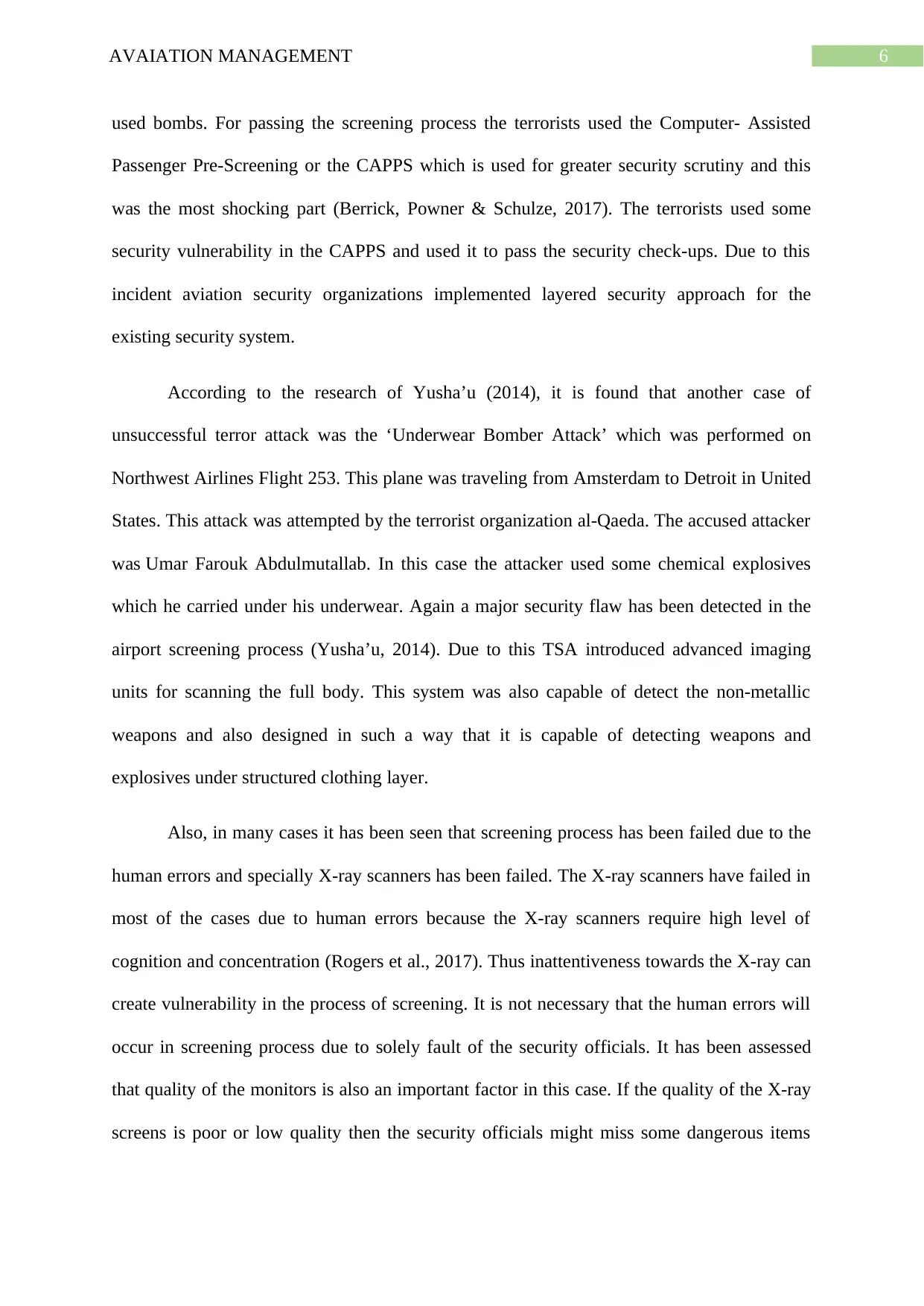
6AVAIATION MANAGEMENT
used bombs. For passing the screening process the terrorists used the Computer- Assisted
Passenger Pre-Screening or the CAPPS which is used for greater security scrutiny and this
was the most shocking part (Berrick, Powner & Schulze, 2017). The terrorists used some
security vulnerability in the CAPPS and used it to pass the security check-ups. Due to this
incident aviation security organizations implemented layered security approach for the
existing security system.
According to the research of Yusha’u (2014), it is found that another case of
unsuccessful terror attack was the ‘Underwear Bomber Attack’ which was performed on
Northwest Airlines Flight 253. This plane was traveling from Amsterdam to Detroit in United
States. This attack was attempted by the terrorist organization al-Qaeda. The accused attacker
was Umar Farouk Abdulmutallab. In this case the attacker used some chemical explosives
which he carried under his underwear. Again a major security flaw has been detected in the
airport screening process (Yusha’u, 2014). Due to this TSA introduced advanced imaging
units for scanning the full body. This system was also capable of detect the non-metallic
weapons and also designed in such a way that it is capable of detecting weapons and
explosives under structured clothing layer.
Also, in many cases it has been seen that screening process has been failed due to the
human errors and specially X-ray scanners has been failed. The X-ray scanners have failed in
most of the cases due to human errors because the X-ray scanners require high level of
cognition and concentration (Rogers et al., 2017). Thus inattentiveness towards the X-ray can
create vulnerability in the process of screening. It is not necessary that the human errors will
occur in screening process due to solely fault of the security officials. It has been assessed
that quality of the monitors is also an important factor in this case. If the quality of the X-ray
screens is poor or low quality then the security officials might miss some dangerous items
used bombs. For passing the screening process the terrorists used the Computer- Assisted
Passenger Pre-Screening or the CAPPS which is used for greater security scrutiny and this
was the most shocking part (Berrick, Powner & Schulze, 2017). The terrorists used some
security vulnerability in the CAPPS and used it to pass the security check-ups. Due to this
incident aviation security organizations implemented layered security approach for the
existing security system.
According to the research of Yusha’u (2014), it is found that another case of
unsuccessful terror attack was the ‘Underwear Bomber Attack’ which was performed on
Northwest Airlines Flight 253. This plane was traveling from Amsterdam to Detroit in United
States. This attack was attempted by the terrorist organization al-Qaeda. The accused attacker
was Umar Farouk Abdulmutallab. In this case the attacker used some chemical explosives
which he carried under his underwear. Again a major security flaw has been detected in the
airport screening process (Yusha’u, 2014). Due to this TSA introduced advanced imaging
units for scanning the full body. This system was also capable of detect the non-metallic
weapons and also designed in such a way that it is capable of detecting weapons and
explosives under structured clothing layer.
Also, in many cases it has been seen that screening process has been failed due to the
human errors and specially X-ray scanners has been failed. The X-ray scanners have failed in
most of the cases due to human errors because the X-ray scanners require high level of
cognition and concentration (Rogers et al., 2017). Thus inattentiveness towards the X-ray can
create vulnerability in the process of screening. It is not necessary that the human errors will
occur in screening process due to solely fault of the security officials. It has been assessed
that quality of the monitors is also an important factor in this case. If the quality of the X-ray
screens is poor or low quality then the security officials might miss some dangerous items
Paraphrase This Document
Need a fresh take? Get an instant paraphrase of this document with our AI Paraphraser
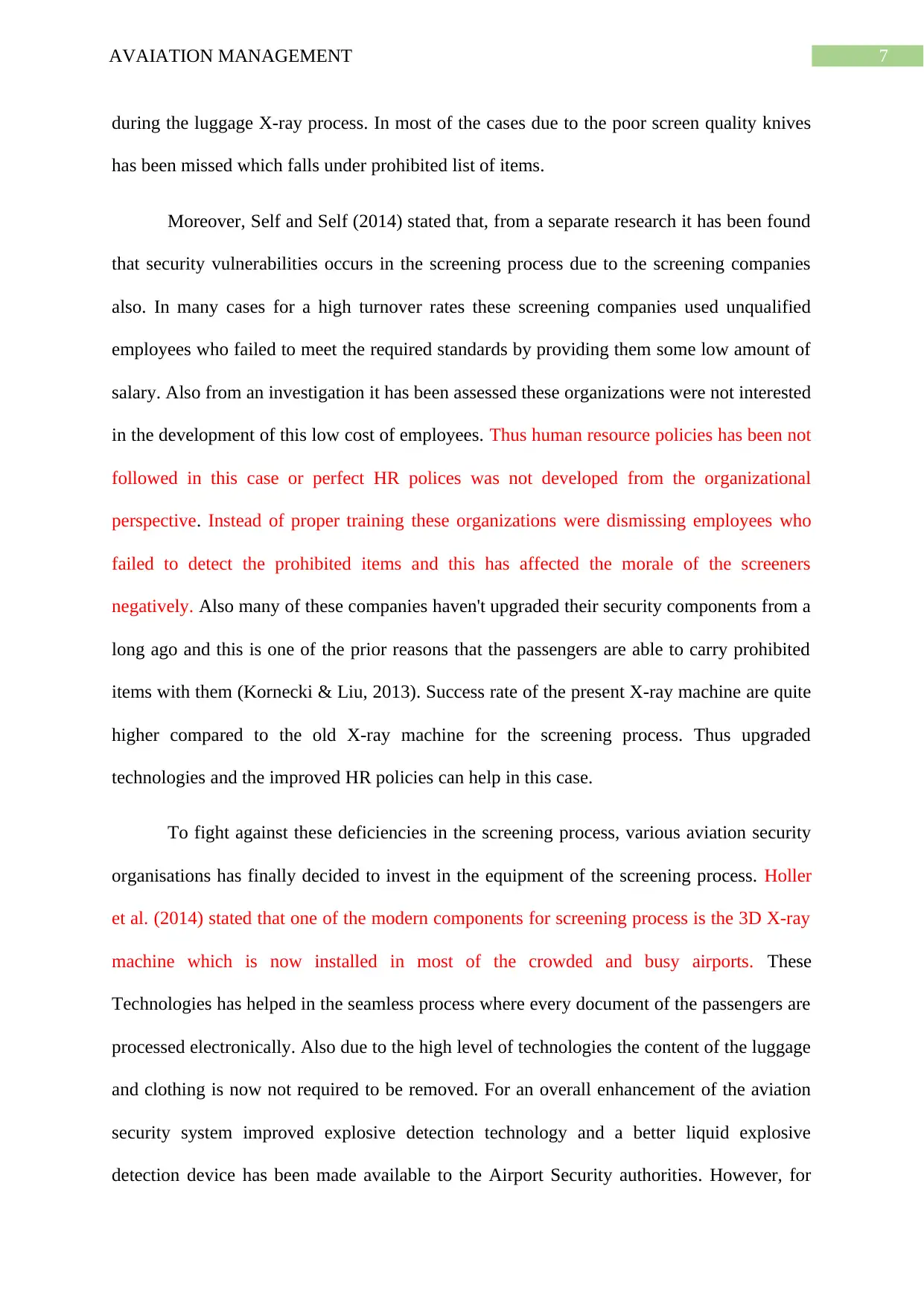
7AVAIATION MANAGEMENT
during the luggage X-ray process. In most of the cases due to the poor screen quality knives
has been missed which falls under prohibited list of items.
Moreover, Self and Self (2014) stated that, from a separate research it has been found
that security vulnerabilities occurs in the screening process due to the screening companies
also. In many cases for a high turnover rates these screening companies used unqualified
employees who failed to meet the required standards by providing them some low amount of
salary. Also from an investigation it has been assessed these organizations were not interested
in the development of this low cost of employees. Thus human resource policies has been not
followed in this case or perfect HR polices was not developed from the organizational
perspective. Instead of proper training these organizations were dismissing employees who
failed to detect the prohibited items and this has affected the morale of the screeners
negatively. Also many of these companies haven't upgraded their security components from a
long ago and this is one of the prior reasons that the passengers are able to carry prohibited
items with them (Kornecki & Liu, 2013). Success rate of the present X-ray machine are quite
higher compared to the old X-ray machine for the screening process. Thus upgraded
technologies and the improved HR policies can help in this case.
To fight against these deficiencies in the screening process, various aviation security
organisations has finally decided to invest in the equipment of the screening process. Holler
et al. (2014) stated that one of the modern components for screening process is the 3D X-ray
machine which is now installed in most of the crowded and busy airports. These
Technologies has helped in the seamless process where every document of the passengers are
processed electronically. Also due to the high level of technologies the content of the luggage
and clothing is now not required to be removed. For an overall enhancement of the aviation
security system improved explosive detection technology and a better liquid explosive
detection device has been made available to the Airport Security authorities. However, for
during the luggage X-ray process. In most of the cases due to the poor screen quality knives
has been missed which falls under prohibited list of items.
Moreover, Self and Self (2014) stated that, from a separate research it has been found
that security vulnerabilities occurs in the screening process due to the screening companies
also. In many cases for a high turnover rates these screening companies used unqualified
employees who failed to meet the required standards by providing them some low amount of
salary. Also from an investigation it has been assessed these organizations were not interested
in the development of this low cost of employees. Thus human resource policies has been not
followed in this case or perfect HR polices was not developed from the organizational
perspective. Instead of proper training these organizations were dismissing employees who
failed to detect the prohibited items and this has affected the morale of the screeners
negatively. Also many of these companies haven't upgraded their security components from a
long ago and this is one of the prior reasons that the passengers are able to carry prohibited
items with them (Kornecki & Liu, 2013). Success rate of the present X-ray machine are quite
higher compared to the old X-ray machine for the screening process. Thus upgraded
technologies and the improved HR policies can help in this case.
To fight against these deficiencies in the screening process, various aviation security
organisations has finally decided to invest in the equipment of the screening process. Holler
et al. (2014) stated that one of the modern components for screening process is the 3D X-ray
machine which is now installed in most of the crowded and busy airports. These
Technologies has helped in the seamless process where every document of the passengers are
processed electronically. Also due to the high level of technologies the content of the luggage
and clothing is now not required to be removed. For an overall enhancement of the aviation
security system improved explosive detection technology and a better liquid explosive
detection device has been made available to the Airport Security authorities. However, for
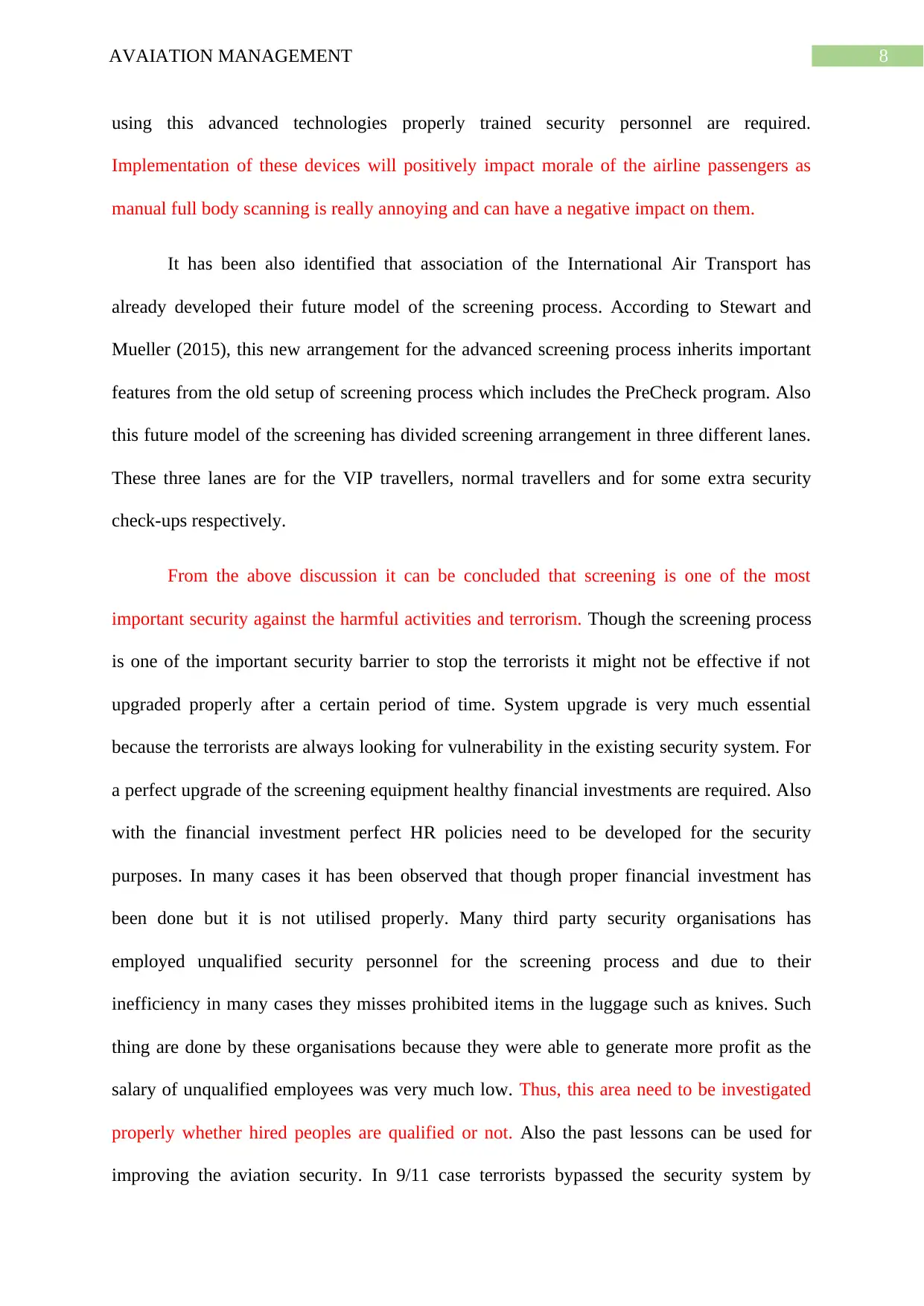
8AVAIATION MANAGEMENT
using this advanced technologies properly trained security personnel are required.
Implementation of these devices will positively impact morale of the airline passengers as
manual full body scanning is really annoying and can have a negative impact on them.
It has been also identified that association of the International Air Transport has
already developed their future model of the screening process. According to Stewart and
Mueller (2015), this new arrangement for the advanced screening process inherits important
features from the old setup of screening process which includes the PreCheck program. Also
this future model of the screening has divided screening arrangement in three different lanes.
These three lanes are for the VIP travellers, normal travellers and for some extra security
check-ups respectively.
From the above discussion it can be concluded that screening is one of the most
important security against the harmful activities and terrorism. Though the screening process
is one of the important security barrier to stop the terrorists it might not be effective if not
upgraded properly after a certain period of time. System upgrade is very much essential
because the terrorists are always looking for vulnerability in the existing security system. For
a perfect upgrade of the screening equipment healthy financial investments are required. Also
with the financial investment perfect HR policies need to be developed for the security
purposes. In many cases it has been observed that though proper financial investment has
been done but it is not utilised properly. Many third party security organisations has
employed unqualified security personnel for the screening process and due to their
inefficiency in many cases they misses prohibited items in the luggage such as knives. Such
thing are done by these organisations because they were able to generate more profit as the
salary of unqualified employees was very much low. Thus, this area need to be investigated
properly whether hired peoples are qualified or not. Also the past lessons can be used for
improving the aviation security. In 9/11 case terrorists bypassed the security system by
using this advanced technologies properly trained security personnel are required.
Implementation of these devices will positively impact morale of the airline passengers as
manual full body scanning is really annoying and can have a negative impact on them.
It has been also identified that association of the International Air Transport has
already developed their future model of the screening process. According to Stewart and
Mueller (2015), this new arrangement for the advanced screening process inherits important
features from the old setup of screening process which includes the PreCheck program. Also
this future model of the screening has divided screening arrangement in three different lanes.
These three lanes are for the VIP travellers, normal travellers and for some extra security
check-ups respectively.
From the above discussion it can be concluded that screening is one of the most
important security against the harmful activities and terrorism. Though the screening process
is one of the important security barrier to stop the terrorists it might not be effective if not
upgraded properly after a certain period of time. System upgrade is very much essential
because the terrorists are always looking for vulnerability in the existing security system. For
a perfect upgrade of the screening equipment healthy financial investments are required. Also
with the financial investment perfect HR policies need to be developed for the security
purposes. In many cases it has been observed that though proper financial investment has
been done but it is not utilised properly. Many third party security organisations has
employed unqualified security personnel for the screening process and due to their
inefficiency in many cases they misses prohibited items in the luggage such as knives. Such
thing are done by these organisations because they were able to generate more profit as the
salary of unqualified employees was very much low. Thus, this area need to be investigated
properly whether hired peoples are qualified or not. Also the past lessons can be used for
improving the aviation security. In 9/11 case terrorists bypassed the security system by

9AVAIATION MANAGEMENT
hacking the system. So from this case improvements can be done in the system software so
that all the vulnerabilities in the software is fixed. These effort of continuous upgrade might
be able to weaken the effort of terrorist in terrorism but it is not assured that screening
process will be always 100% accurate. After proper system upgrade it still can face security
architecture issue due to the socio-economic, technological and demographic changes for
both foreign and domestic needs.
hacking the system. So from this case improvements can be done in the system software so
that all the vulnerabilities in the software is fixed. These effort of continuous upgrade might
be able to weaken the effort of terrorist in terrorism but it is not assured that screening
process will be always 100% accurate. After proper system upgrade it still can face security
architecture issue due to the socio-economic, technological and demographic changes for
both foreign and domestic needs.
Secure Best Marks with AI Grader
Need help grading? Try our AI Grader for instant feedback on your assignments.
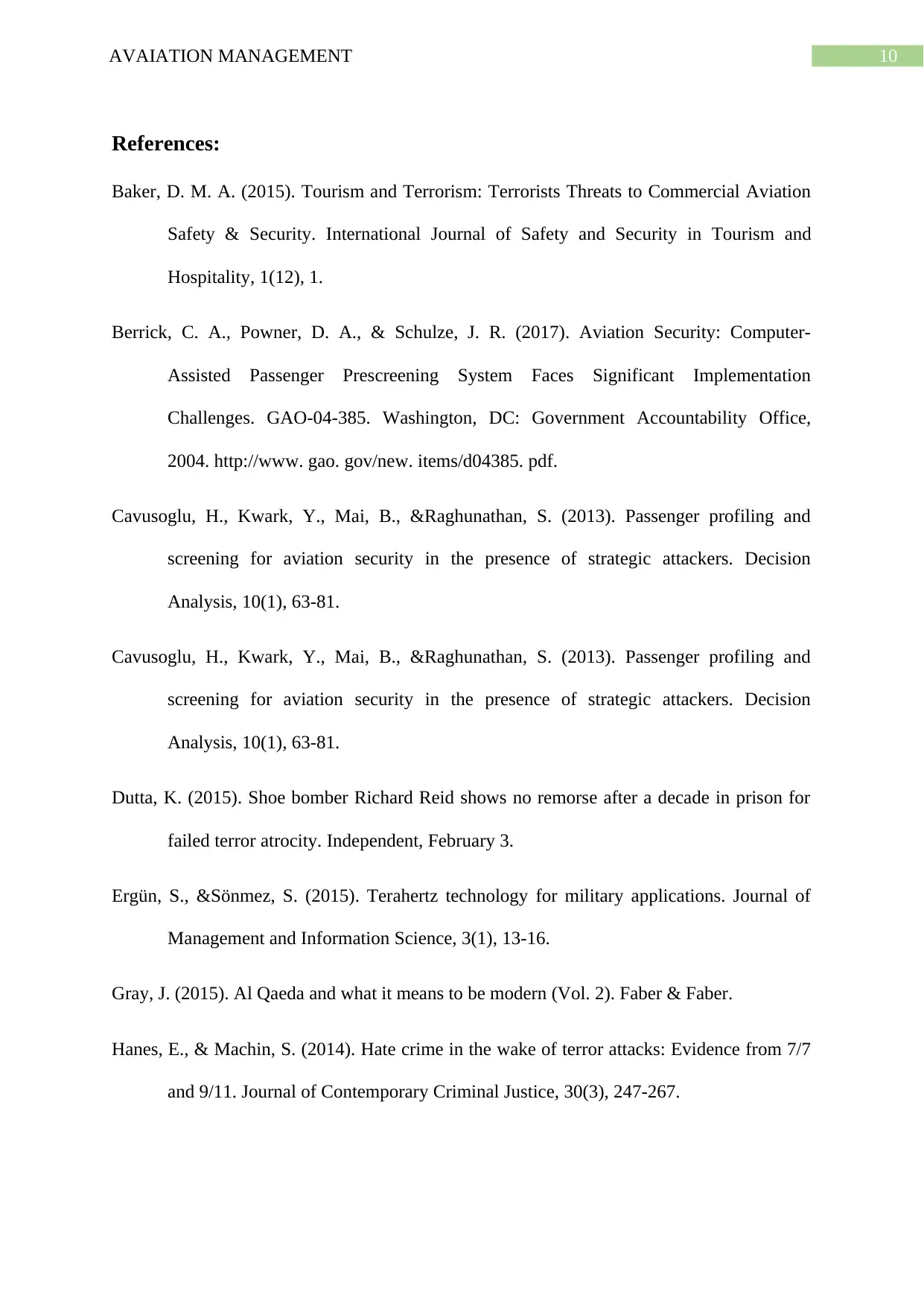
10AVAIATION MANAGEMENT
References:
Baker, D. M. A. (2015). Tourism and Terrorism: Terrorists Threats to Commercial Aviation
Safety & Security. International Journal of Safety and Security in Tourism and
Hospitality, 1(12), 1.
Berrick, C. A., Powner, D. A., & Schulze, J. R. (2017). Aviation Security: Computer-
Assisted Passenger Prescreening System Faces Significant Implementation
Challenges. GAO-04-385. Washington, DC: Government Accountability Office,
2004. http://www. gao. gov/new. items/d04385. pdf.
Cavusoglu, H., Kwark, Y., Mai, B., &Raghunathan, S. (2013). Passenger profiling and
screening for aviation security in the presence of strategic attackers. Decision
Analysis, 10(1), 63-81.
Cavusoglu, H., Kwark, Y., Mai, B., &Raghunathan, S. (2013). Passenger profiling and
screening for aviation security in the presence of strategic attackers. Decision
Analysis, 10(1), 63-81.
Dutta, K. (2015). Shoe bomber Richard Reid shows no remorse after a decade in prison for
failed terror atrocity. Independent, February 3.
Ergün, S., &Sönmez, S. (2015). Terahertz technology for military applications. Journal of
Management and Information Science, 3(1), 13-16.
Gray, J. (2015). Al Qaeda and what it means to be modern (Vol. 2). Faber & Faber.
Hanes, E., & Machin, S. (2014). Hate crime in the wake of terror attacks: Evidence from 7/7
and 9/11. Journal of Contemporary Criminal Justice, 30(3), 247-267.
References:
Baker, D. M. A. (2015). Tourism and Terrorism: Terrorists Threats to Commercial Aviation
Safety & Security. International Journal of Safety and Security in Tourism and
Hospitality, 1(12), 1.
Berrick, C. A., Powner, D. A., & Schulze, J. R. (2017). Aviation Security: Computer-
Assisted Passenger Prescreening System Faces Significant Implementation
Challenges. GAO-04-385. Washington, DC: Government Accountability Office,
2004. http://www. gao. gov/new. items/d04385. pdf.
Cavusoglu, H., Kwark, Y., Mai, B., &Raghunathan, S. (2013). Passenger profiling and
screening for aviation security in the presence of strategic attackers. Decision
Analysis, 10(1), 63-81.
Cavusoglu, H., Kwark, Y., Mai, B., &Raghunathan, S. (2013). Passenger profiling and
screening for aviation security in the presence of strategic attackers. Decision
Analysis, 10(1), 63-81.
Dutta, K. (2015). Shoe bomber Richard Reid shows no remorse after a decade in prison for
failed terror atrocity. Independent, February 3.
Ergün, S., &Sönmez, S. (2015). Terahertz technology for military applications. Journal of
Management and Information Science, 3(1), 13-16.
Gray, J. (2015). Al Qaeda and what it means to be modern (Vol. 2). Faber & Faber.
Hanes, E., & Machin, S. (2014). Hate crime in the wake of terror attacks: Evidence from 7/7
and 9/11. Journal of Contemporary Criminal Justice, 30(3), 247-267.
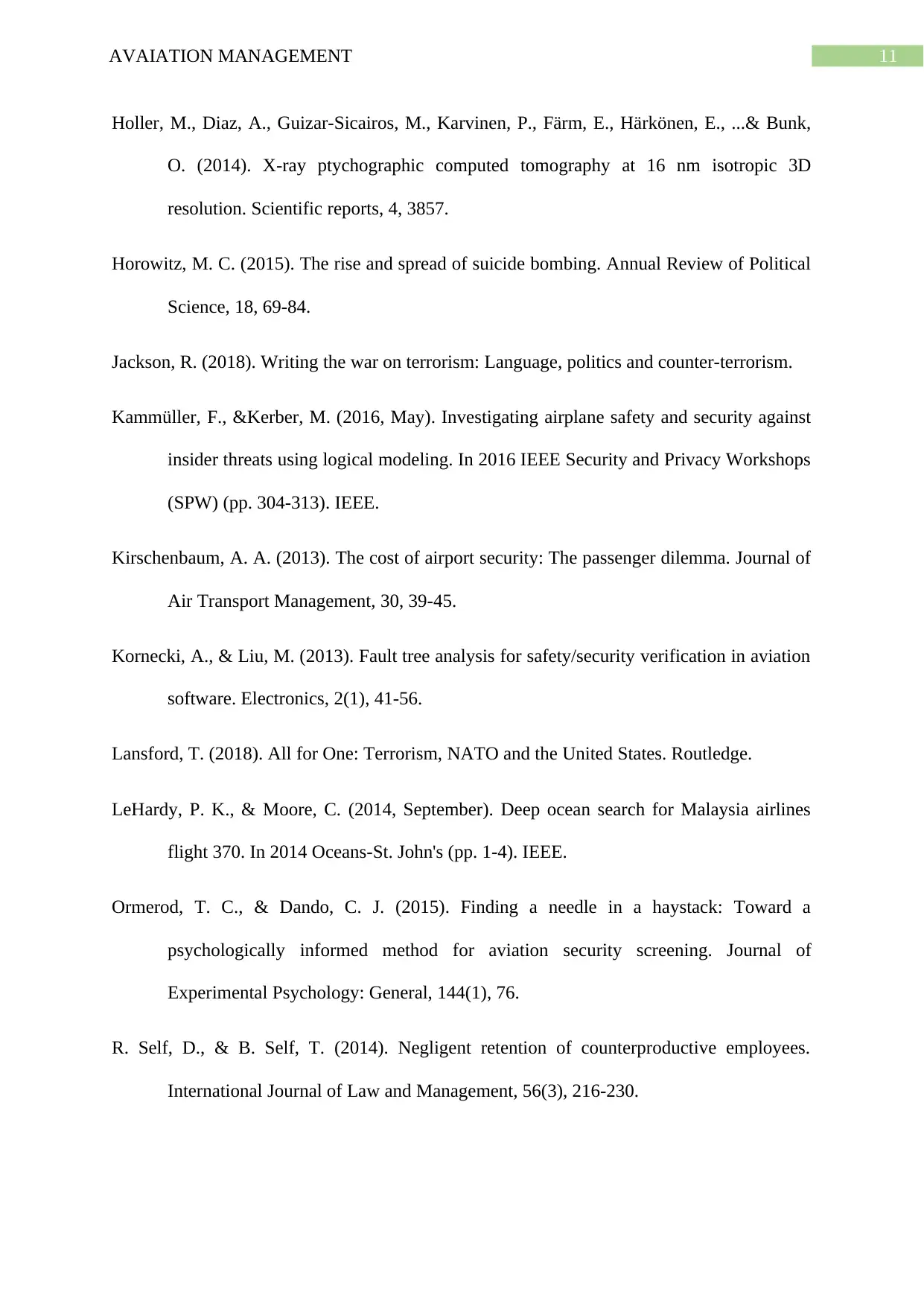
11AVAIATION MANAGEMENT
Holler, M., Diaz, A., Guizar-Sicairos, M., Karvinen, P., Färm, E., Härkönen, E., ...& Bunk,
O. (2014). X-ray ptychographic computed tomography at 16 nm isotropic 3D
resolution. Scientific reports, 4, 3857.
Horowitz, M. C. (2015). The rise and spread of suicide bombing. Annual Review of Political
Science, 18, 69-84.
Jackson, R. (2018). Writing the war on terrorism: Language, politics and counter-terrorism.
Kammüller, F., &Kerber, M. (2016, May). Investigating airplane safety and security against
insider threats using logical modeling. In 2016 IEEE Security and Privacy Workshops
(SPW) (pp. 304-313). IEEE.
Kirschenbaum, A. A. (2013). The cost of airport security: The passenger dilemma. Journal of
Air Transport Management, 30, 39-45.
Kornecki, A., & Liu, M. (2013). Fault tree analysis for safety/security verification in aviation
software. Electronics, 2(1), 41-56.
Lansford, T. (2018). All for One: Terrorism, NATO and the United States. Routledge.
LeHardy, P. K., & Moore, C. (2014, September). Deep ocean search for Malaysia airlines
flight 370. In 2014 Oceans-St. John's (pp. 1-4). IEEE.
Ormerod, T. C., & Dando, C. J. (2015). Finding a needle in a haystack: Toward a
psychologically informed method for aviation security screening. Journal of
Experimental Psychology: General, 144(1), 76.
R. Self, D., & B. Self, T. (2014). Negligent retention of counterproductive employees.
International Journal of Law and Management, 56(3), 216-230.
Holler, M., Diaz, A., Guizar-Sicairos, M., Karvinen, P., Färm, E., Härkönen, E., ...& Bunk,
O. (2014). X-ray ptychographic computed tomography at 16 nm isotropic 3D
resolution. Scientific reports, 4, 3857.
Horowitz, M. C. (2015). The rise and spread of suicide bombing. Annual Review of Political
Science, 18, 69-84.
Jackson, R. (2018). Writing the war on terrorism: Language, politics and counter-terrorism.
Kammüller, F., &Kerber, M. (2016, May). Investigating airplane safety and security against
insider threats using logical modeling. In 2016 IEEE Security and Privacy Workshops
(SPW) (pp. 304-313). IEEE.
Kirschenbaum, A. A. (2013). The cost of airport security: The passenger dilemma. Journal of
Air Transport Management, 30, 39-45.
Kornecki, A., & Liu, M. (2013). Fault tree analysis for safety/security verification in aviation
software. Electronics, 2(1), 41-56.
Lansford, T. (2018). All for One: Terrorism, NATO and the United States. Routledge.
LeHardy, P. K., & Moore, C. (2014, September). Deep ocean search for Malaysia airlines
flight 370. In 2014 Oceans-St. John's (pp. 1-4). IEEE.
Ormerod, T. C., & Dando, C. J. (2015). Finding a needle in a haystack: Toward a
psychologically informed method for aviation security screening. Journal of
Experimental Psychology: General, 144(1), 76.
R. Self, D., & B. Self, T. (2014). Negligent retention of counterproductive employees.
International Journal of Law and Management, 56(3), 216-230.
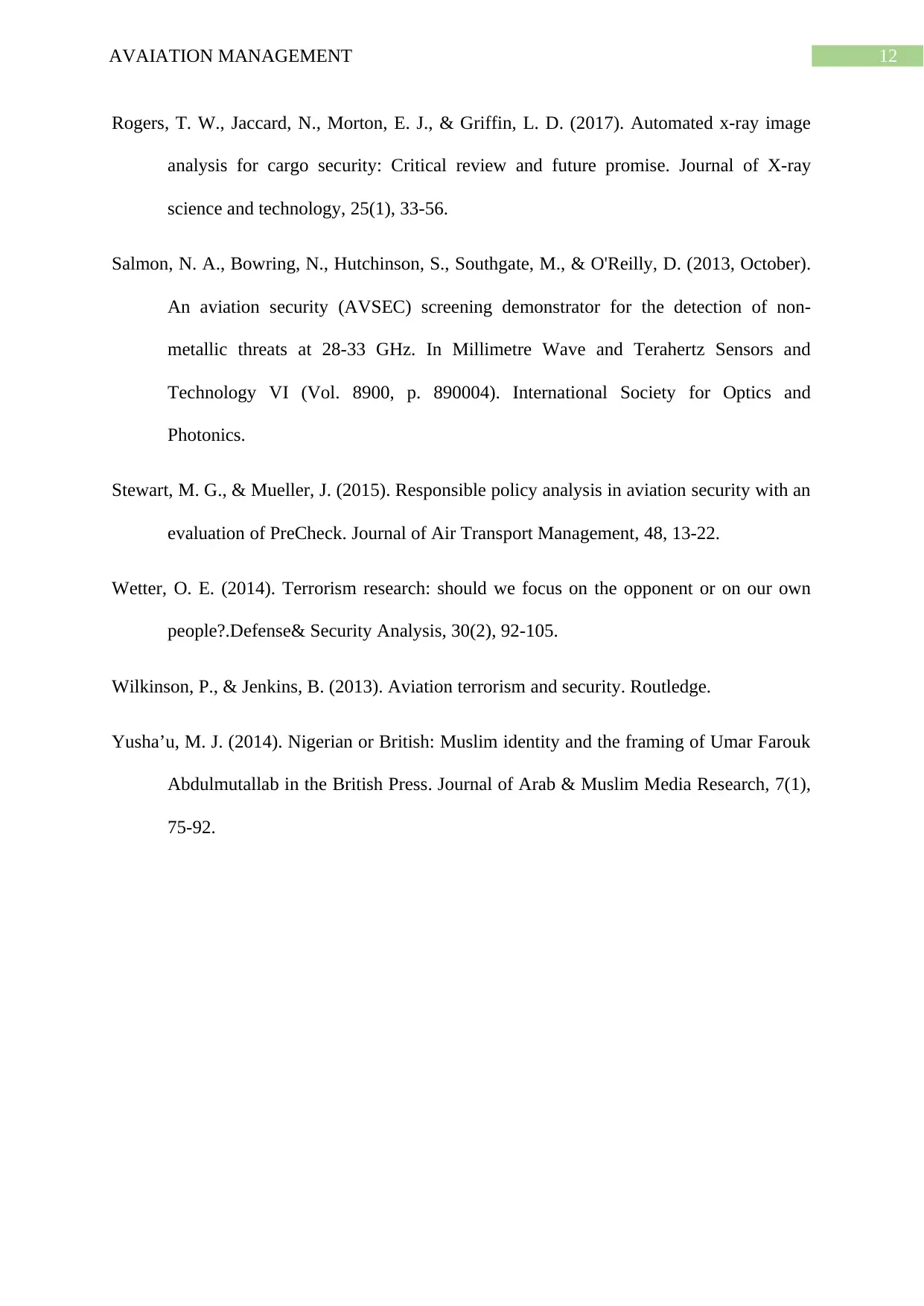
12AVAIATION MANAGEMENT
Rogers, T. W., Jaccard, N., Morton, E. J., & Griffin, L. D. (2017). Automated x-ray image
analysis for cargo security: Critical review and future promise. Journal of X-ray
science and technology, 25(1), 33-56.
Salmon, N. A., Bowring, N., Hutchinson, S., Southgate, M., & O'Reilly, D. (2013, October).
An aviation security (AVSEC) screening demonstrator for the detection of non-
metallic threats at 28-33 GHz. In Millimetre Wave and Terahertz Sensors and
Technology VI (Vol. 8900, p. 890004). International Society for Optics and
Photonics.
Stewart, M. G., & Mueller, J. (2015). Responsible policy analysis in aviation security with an
evaluation of PreCheck. Journal of Air Transport Management, 48, 13-22.
Wetter, O. E. (2014). Terrorism research: should we focus on the opponent or on our own
people?.Defense& Security Analysis, 30(2), 92-105.
Wilkinson, P., & Jenkins, B. (2013). Aviation terrorism and security. Routledge.
Yusha’u, M. J. (2014). Nigerian or British: Muslim identity and the framing of Umar Farouk
Abdulmutallab in the British Press. Journal of Arab & Muslim Media Research, 7(1),
75-92.
Rogers, T. W., Jaccard, N., Morton, E. J., & Griffin, L. D. (2017). Automated x-ray image
analysis for cargo security: Critical review and future promise. Journal of X-ray
science and technology, 25(1), 33-56.
Salmon, N. A., Bowring, N., Hutchinson, S., Southgate, M., & O'Reilly, D. (2013, October).
An aviation security (AVSEC) screening demonstrator for the detection of non-
metallic threats at 28-33 GHz. In Millimetre Wave and Terahertz Sensors and
Technology VI (Vol. 8900, p. 890004). International Society for Optics and
Photonics.
Stewart, M. G., & Mueller, J. (2015). Responsible policy analysis in aviation security with an
evaluation of PreCheck. Journal of Air Transport Management, 48, 13-22.
Wetter, O. E. (2014). Terrorism research: should we focus on the opponent or on our own
people?.Defense& Security Analysis, 30(2), 92-105.
Wilkinson, P., & Jenkins, B. (2013). Aviation terrorism and security. Routledge.
Yusha’u, M. J. (2014). Nigerian or British: Muslim identity and the framing of Umar Farouk
Abdulmutallab in the British Press. Journal of Arab & Muslim Media Research, 7(1),
75-92.
1 out of 13
Related Documents
Your All-in-One AI-Powered Toolkit for Academic Success.
+13062052269
info@desklib.com
Available 24*7 on WhatsApp / Email
![[object Object]](/_next/static/media/star-bottom.7253800d.svg)
Unlock your academic potential
© 2024 | Zucol Services PVT LTD | All rights reserved.





